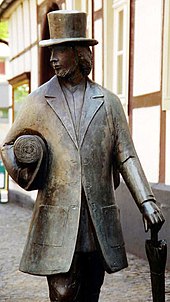Dead trade
The death trade as a special form of Holland walk was in the 17th / 18th centuries. Century part of a goods trading system, the North Sea system , which extended to the Baltic States .
Tödden even Tüötten or Tiötten called, were seasonal wandering merchants and peddlers from Westphalia and neighboring regions, particularly the one prepared in rural and domestic enterprises during the winter lines in the following summer only in the Netherlands (coll. Holland) and then in Northern Europe , sold from England to Riga. The name Tödden is supposed to come from Dutch and mean swapping, trading . In another reading, the term should be derived from the Low German deadly 'drag', 'pull', 'trot heavily packed'. The analog name Tüötten or Tiötten have emerged from various local pronunciations.
Development of the dead trade
The trade began as a barter trade after the Thirty Years War , when later-born peasant sons hired themselves as peat cutters and in agriculture in Holland and wanted to earn extra income by selling surplus linen rolls. The Dutch used the heavy, firm linen as canvas for their sailing ships and for weatherproof clothing. Some migrant workers quickly found that trading was easier and more money-making than heavy farming. A lively trade initially developed in yarns and fabrics . Metal goods were added later.
The flourishing of the killing system was causally related to the free trade policy of the Netherlands. The Töddenwesen in the county of Lingen was particularly favored by the existing highways. With the development of new sales areas in the rest of Northern Europe and the strong demand for cloths, a certain prosperity arose in the hometowns of the Tödden. Several Töddenhäuser still exist here today . According to recent research, the trading volume must have been considerable.
The deadly system
One can speak of a veritable “ Tödd system ” that was tightly organized: Each Tödde had its specific sales area and thus a fixed customer base. The Tödden were a more or less self-contained society, they even used their own language, known and used only among their male members, Bargunsch or Humpisch . Finally, a product specialization developed with a division of labor organized by stratification in wholesalers and sellers on site. Family and economic connections developed between the regions of origin and sales areas through marriages, which ultimately led to trading companies with fixed economic forms of organization, mostly on a family basis.
Westphalian Tödden were mainly located in the Tecklenburger Land in the municipalities of Mettingen , Hopsten , Recke and Ibbenbüren . But they also existed in the North Munsterland Rheine , as well as in southern Westphalia, especially in Winterberg . But there were also Tödden in Schapen , Beesten , Freren , Messingen and Thuine , as evidenced by concession applications, other written documents and Tödden houses. The Mettinger "Tüötten Museum" is dedicated to the history of the Tödden trade and especially the living conditions of the Mettinger Tüötten families.
Competition with the dead
The dead were by no means welcomed everywhere. It often happened that the local merchants viewed them as unwelcome competition and demanded regulatory regulations. So Prussia issued 1703-1806 commercial policy measures against the dead in the central and eastern provinces with confiscation of their goods and a ban on peddling.
Establishment as a resident dealer
Some traveling traders succeeded in establishing themselves in the respective towns and becoming a merchant. The development thus proceeded from outpatient to stationary retail. Well-known, large trading houses such as C&A Brenninkmeijer (Brenninkmeyer), Hettlage , Boecker or Peek & Cloppenburg (P&C) have developed from Tödden communities.
End of the dead trade
The greatest expansion of the dead trade was in the 18th century. The decline began after 1818. The end of the continental lock changed the economic situation. The newly established factories in England, which printed the calico themselves, also collected and transported the bales of cloth. The Tödden's branches began to shrink. This process was intensified by the newly emerging railways , which offered greater mobility and could transport larger quantities.
See also
literature
- Hannelore Oberpenning: Migration and long-distance trade in the Tödden system. Wandering trader from northern Münsterland in central and northern Europe in the 18th and 19th centuries . (Studies on historical migration research, Volume 4; also dissertation). Rasch, Osnabrück 1996, ISBN 3-930595-34-6
- Bernhard Nonte, Eugen Eslage et al .: Tüötten Museum Mettingen. A museum within a museum . Museum guide, published by the Heimatverein Mettingen. Ibbenbürener Vereindruckerei, Ibbenbüren 2002, ISBN 3-932959-25-6
- Klaas Goinga: On the trail of the dead . Ibbenbürener Vereindruck, Ibbenbüren 1995, ISBN 3-921290-84-8
- Josef Veldtrup: Bargunsch or humpisch. The secret language of the Westphalian Tiötten . Aschendorff 1981, ISBN 3-402-05985-1
- Hubert Rickelmann : Die Tüötten in their trade and change. A contribution to the economic, social and family history in the former Upper County of Lingen, the County of Tecklenburg and the neighboring areas . Ferdinand Schöningh Verlag, Paderborn 1960, 2nd edition 1976, ISBN 3-506-77221-X

